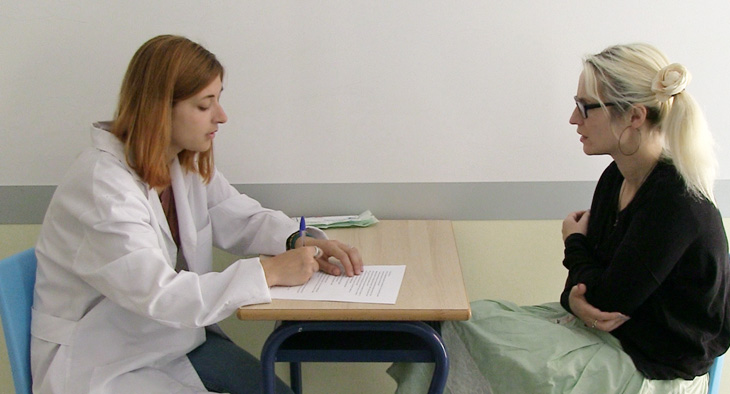In this section you will practise asking and answering questions when taking a medical history.
1. Vocabulary review.

Review vocabulary from the previous section. Can you remember these words? Read the definitions and type the words in the boxes.
How did you do? Were all your answers correct? Do the exercise again and try to improve your score.
2. Vocabulary: Taking a medical history.

In the following exercises you will look at video clips from a consultation with a patient. In this exercise you practise vocabulary from the video clips. Read the example sentences and match the words in bold to the definitions.
Examples:
My sore throat is very annoying.
I have a sore throat and it’s difficult for me to swallow.
When you have a cold you sneeze and cough.
When you have a cough, sometimes you cough up phlegm.
It’s not good to eat a large amount of food just before you go to bed.
Patients can use a scale of 1 to 10 to describe the intensity of pain.
Headaches can be very painful.
Aspirin and paracetamol are over-the-counter drugs.
Paracetamol and ibuprofen are painkillers.
I sometimes get a mouth ulcer when I am stressed and tired.
Note: In glossary entries adj = adjective, v = verb, and n = noun.
4. Taking a medical history.
Watch five short clips. Which part of the consultation do they correspond to? Choose the correct option. This exercise is in two parts. Scroll down to see the second part.
Now watch five more clips and choose the correct option.
5. Taking a medical history.
Watch the first part of the consultation and choose the correct options to complete the notes.
6. Introductions.
Use the phrases to complete the first part of the consultation.
Now watch the video and read the subtitles.
7. Responding to the patient’s answers.
During the consultation the nurse practitioner asks a lot of questions and always responds to what the patient says. The nurse practitioner uses different words and phrases to do this. Listen to part of the consultation and choose the options that the nurse practitioner uses.
Now listen and read the dialogue.
8. Questions: Word order.
Put the words in order to complete questions from the consultation.
Now listen and repeat the questions.
9. Asking about past medical history.
Watch the next part of the consultation and mark the sentences true or false.
10. Useful phrases.
Use the phrases to complete part of the dialogue from the previous exercise. This exercise is in two parts.
Part 1
Part 2
11. Asking about past medical history.
Watch the last part of the consultation and choose the correct options to complete the sentences.
Now you can watch the complete consultation and read the subtitles.
13. Time and frequency: Practice.
Can you remember? Use the words to complete the sentences.
Describing frequency
We can describe frequency in different ways:
first thing in the morning = early, as soon as I am awake
once
once a day, once every two days, once a week, …
once a day, twice a day, three times a day, …
every
every hour, every day, every month, …
Adverbs of frequency
How often do you have a check-up?
Do you have check-ups regularly?
I never/hardly ever/sometimes/often/always have headaches.
Speaking Tutorial 1 (Talk about your work and practise asking questions.)
In this tutorial your tutor will play the role of a patient and you will interview him or her and take a medical history. Remember to do the following:
- Introduce yourself
- Ask what name the patient prefers to be called
- Ask about a chief complaint
- Ask for detailed information
- Ask about medical history
- Respond to what the patient says
